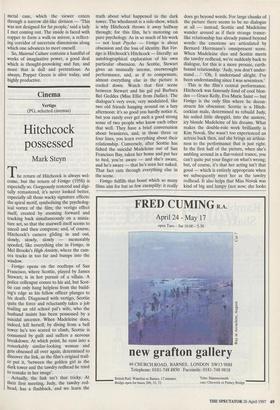Cinema
Vertigo (PG, selected cinemas)
Hitchcock possessed
Mark Steyn
The return of Hitchcock is always wel- come, but the return of Vertigo (1958) is especially so. Gorgeously restored and digi- tally remastered, it's never looked better, especially all those wacky signature effects: the spiral motif, symbolising the psycholog- ical vortex of the film; the vertigo effect itself, created by zooming forward and tracking back simultaneously on a minia- ture set, so that the stairwell itself seems to uncoil and then compress; and, of course, Hitchcock's camera gliding in and out, slowly, slowly, slowly — memorably spoofed, like everything else in Vertigo, in Mel Brooks's High Anxiety, where the cam- era tracks in too far and bumps into the window.
Vertigo opens on the rooftops of San Francisco, where Scottie, played by James Stewart, is in hot pursuit of a villain. A police colleague comes to his aid, but Scot- tie can only hang helpless from the build- ing's edge as his fellow officer plunges to his death. Diagnosed with vertigo, Scottie quits the force and reluctantly takes a job trailing an old school pal's wife, who the husband insists has been possessed by a suicidal ancestor. When Madeleine does, indeed, kill herself, by diving from a bell tower he's too scared to climb, Scottie is consumed by guilt and suffers a nervous breakdown. At which point, he runs into a remarkably similar-looking woman and gets obsessed all over again, determined to discover the link, as the film's original trail- er put it, 'between the golden girl in the dark tower and the tawdry redhead he tried to remake in her image'.
Actually, the link isn't that tricky. At their first meeting, Judy, the tawdry red- head, has a flashback, and we learn the truth about what happened in the dark tower. The whodunnit is a side-show, which is why Hitchcock throws it away halfway through; for this film, he's motoring on pure psychology. As in so much of his work — not least Psycho — Vertigo is about obsession and the loss of identity. But Ver- tigo is Hitchcock's Hitchcock — literally: an autobiographical exploration of his own particular obsession. As Scottie, Stewart gives an unusually intense, overwrought performance, and, as if to compensate, almost everything else in the picture is cooled down. Watch that first scene between Stewart and his gal pal Barbara Bel Geddes (Miss Ellie from Dallas). The dialogue's very even, very modulated, like two old friends hanging around on a lazy afternoon: it's so good you hardly notice it, but you rarely ever get such a good strong sense of two people who know each other that well. They have a brief conversation about brassieres, and, in those three or four lines, you learn everything about their relationship. Conversely, after Scottie has fished the suicidal Madeleine out of San Francisco Bay, taken her home and put her to bed, you're aware — and she's aware, and he's aware — that he's seen her naked. That fact cuts through everything else in the scene.
Vertigo fulfills that boast which so many films aim for but so few exemplify: it really does go beyond words. For large chunks of the picture there seems to be no dialogue at all — instead, Scottie and Madeleine wander around as if their strange trance- like relationship has already passed beyond words: the emotions are articulated by Bernard Herrmann's omnipresent score. When Madeleine dies and Scottie meets the tawdry redhead, we're suddenly back to dialogue, for this is a more prosaic, earth- bound relationship: 'Judy, you don't under- stand . .."Oh, I understand alright. I've been understanding since I was seventeen.'
This is the film's central performance. Hitchcock was famously fond of cool blon- des — Grace Kelly, Eva Marie Saint — but Vertigo is the only film where he decon- structs his obsession: Scottie is a Hitch- cockian male, determined to rebuild Judy, his soiled little shopgirl, into the austere, icy blonde Madeleine of his dreams. What makes the double-role work brilliantly is Kim Novak. She wasn't too experienced an actress back then, and she brings an artless- ness to the performance that is just right. In the first half of the picture, when she's ambling around in a flat-voiced trance, you can't quite put your finger on what's wrong; but, of course, it's that her acting isn't that good — which is entirely appropriate when we subsequently meet her as the tawdry redhead. It also helps that Miss Novak was kind of big and lumpy (not now; she looks fantastic these days), so she seems, even as she's all dolled up as one of San Francis- co's finest ladies, as if she's not quite at ease.
Hitchcock was acknowledging the futility of his fantasies: a 'woman of mystery' enigmatic, few words — is a woman who's fine for a mystery but can't keep it up for- ever; the moment you get to know her, the spell is broken. He believed that every beautiful woman is a deception, and it prompted in him a sort of sensual equiva- lent to his vertigo effect — simultaneously drawn in and repelled. 'Why are you doing this?' demands Novak, as Stewart demands she assume the dead woman's hair and clothes. 'What good will it do?' I don't know,' he says. 'No good, I guess. I don't know . . .' He reaches to caress her face but then pulls away. In that one moment, Hitchcock's entire approach to his leading ladies is brilliantly condensed.



































































 Previous page
Previous page